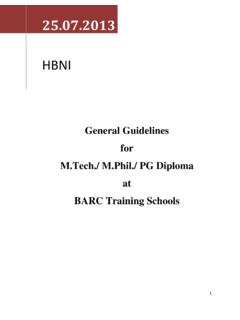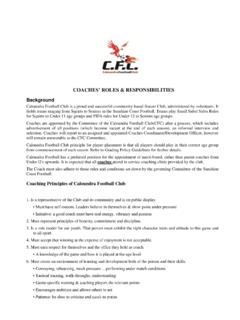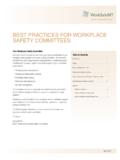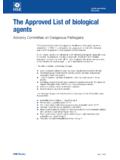Transcription of Guidelines for roles and responsibilities of …
1 Approved in the meeting of the Standing Committee of Deans held on Guidelines for roles and responsibilities of guides/co-guides, doctoral committees , deans-academic and standing academic committees A doctoral thesis is expected to be a significant original and independent contribution to knowledge in a chosen field of study and be of such lasting value as to merit publication. It should demonstrate an ability to select an important problem and deal with it completely including an ability to effectively communicate what has been achieved through the research activity. It should be short, preferably less than 200. pages and in any case not longer than 300 pages. A Master's thesis must show that the student is able to work in a scholarly manner and is acquainted with the principal works published on the subject of the thesis. It should demonstrate readiness of the student to pursue research and an ability to communicate complex issues in a cogent manner in about 100 pages.
2 A guide or a supervisor plays a very important role in the entire process viz., identification of the topic of research, formulation of the problem in a manner that is appropriate for the degree, guidance about the nature of research and the standard expected, planning research so as to complete it in accordance of the time table specified by the university, writing the thesis and getting it examined. Since the total duration of the programme can be three to four years, the guide has to be a regular faculty or should have at least four years of contract1. Recognition as faculty is given by the Boards of Studies, and they may decide to advise a faculty member to gain experience in guiding a student as a co-guide (along with a senior faculty as a guide). before permitting him to take up a student as a guide. Board of Studies may also advise a member of faculty to gain experience by guiding or students before taking up a doctoral student.
3 To provide oversight on all issues related to the academic progress made by the student, to resolve any student-guide conflict, and to assure quality of a thesis, the Institute relies on student specific doctoral committees . A doctoral committee provides a safety net for both the student and the guide. Corresponding committees for or are known as monitoring committees . HBNI has a distributed structure and with a view to localize administration, to the extent possible, each Constituent Institution (CI) has Deans-Academic. Number of Deans- 1. Many positions in CIs could be temporary such as Raja Ramanna Fellows. Raja Ramanna Fellowship is given initially for a period of three years and there is no guarantee of its renewal. In order to derive benefit of expertise of such individuals, it has been decided that such individuals can be co guides. An Individual holding such temporary positions can also be appointed a member or a chairman of doctoral committees for the duration of their appointment or even beyond.
4 Of appointed beyond the duration of their tenure as RRF, responsibility for payment of honorarium, if any, lies with the CI. 1 Approved in the meeting of the Standing Committee of Deans held on Academic at a CI depends upon the strength of students and diversity of subjects. Acting as a link between the Central Office in Mumbai and the CI, Deans-Academic speedily perform several functions and bring efficiency in managing the affairs of the Institute. The process of admissions is handled by appropriate committees at each CI in an independent manner. HBNI has two kinds of research students: (i) individuals who join HBNI as students after graduation from universities, hereinafter called students(s), and (ii) individuals who are employees of units of Department of Atomic Energy (DAE) and work for their while on the job, hereinafter called students(e). Some CIs have same committees for both categories of students, while others have different committees so as to share the work load.
5 For one particular category of students 2 , selection is managed by the HRDD, BARC and students are distributed to CIs based on their research interest. This document is meant for faculty and outlines role and responsibilities of guides, co- guides, doctoral committees , deans-academic and standing academic committees with respect to managing research students. While every care has been taken to ensure that all statements in these Guidelines are compatible with ordinances, in case of any conflict, ordinances will prevail. 1. Role and responsibility of guides Helping a new scholar to become an independent researcher is a significant achievement for someone engaged in higher education. This achievement is so satisfying that many students and supervisors stay in contact for the rest of their academic career. Most members of faculty need some guidance before taking a student for the first time. That is why HBNI considers it desirable that a young faculty member first works as a co-guide alongside a more experienced guide or guides students for or to acquire experience.
6 At what stage, a member of faculty can take up a student is decided at the level of the CI with guidance from respective Board of Studies. Experience as a co-guide is desirable and not a must as doctoral committees do provide appropriate direction to the student and the guide. The purpose of this document is to supplement hands-on experience. Literature3 on this subject can be downloaded from the internet and faculty members are encouraged to read to understand fine nuances of guiding research students. 2. This is in respect of the students admitted under DAE Graduate Fellowship Scheme (DGFS) explained later. 3. Richard James and Gabrielle Baldwin, Eleven practices of effective postgraduate supervisors, The University of Melbourne, 1999 is a good document and is available on the internet. Those who are interested in more details may see a paper by Anne Lee, How are doctoral students supervised? Concepts of doctoral research supervision, 2 Approved in the meeting of the Standing Committee of Deans held on The following guidance is primarily aimed at supervision, but much of it will also be useful for other research programmes, such as or A guide should be a recognized faculty member of the HBNI and should have been authorized to guide students.
7 The Guide should help the student in writing a research proposal for programme. First step towards this end is to make sure that his/her area of expertise matches with the research interests of the student. If necessary, guide may decide to take a co-guide or a technology adviser. The second step is to identify a topic that is within the mandate of the DAE and the CI, so that availability of research facilities and funding for their augmentation, if any, is taken care of. The stage at which guide and the topic are identified differs for the two types of students. o In case of students(s), the initial period is spent on the course work and getting acquainted. CIs have put in place a monitoring mechanism to track progress of students during the course work and identification of a guide and a topic for research is done at the end of the course work. For students joining programme after , the guide and the topic are identified in the first few weeks.
8 O Students(e) are invariably exposed to the subject during their professional activities, and are, therefore, expected to formulate the research problem at the time of appearing before the standing academic committee for selection for the programme. The first identification of course work (class room courses, self-study courses and credit seminars) to be done by the student(e) is also done at this stage. Doctoral Committee is also identified by the standing committee. Once Guide and the broad topic have been decided, further details of the problem are formulated in a manner that it enables research embodying new knowledge appropriate for the degree to be completed within the specified time. Experience of the Guide is an essential element in formulating the problem and it is Guide's responsibility to ensure that the details are appropriately worked out. The Guide has to ensure that appropriate literature survey is done by the student and the student is able to defend the proposal before the doctoral committee.
9 Looking at the problem detail, the guide can modify course work specification. The process of identifying class room courses, self study courses and credit Studies on Higher Education, Vol 33, No 3, June 2008, 267 281. The publication Review of Wellcome Trust research Training: The Supervisor Perspective published in 2001 is also worth reading. 3 Approved in the meeting of the Standing Committee of Deans held on seminars has to be a dynamic process and needs to be tuned to the requirements of the research work as its definition progresses. Students may also be encouraged to listen to on-line courses that are available on internet. The Guide should make sure that the student has completed all recommended credit courses and/or credit seminars (within about two year of enrolment). Mark sheet for self-study courses and credit seminars should be as per approved format. The Guide has to make sure that for students, who to start with have only a monitoring committee, get a doctoral committee once the topic for research has been formulated.
10 Ordinance specify that the guide is the convener of the Doctoral Committee of the student. The Guide can, in consultation with Dean- Academic, seek change of the Doctoral Committee if needed. The guide should prepare the student to go through the Oral General Comprehensive examination within about two years of enrolment. OGCE report should be prepared as per approved format. The Guide is expected to provide a framework within which the academic work can take place by: o setting up a regular schedule of meetings with student to allow for regular interaction and information flow;. o reaching agreement with student on indicators of progress being made and dates for submission of progress reports; and o providing regular and prompt feedback on progress to student (including written feedback on written work within two weeks unless the written work is extensive). The Guide is expected to provide academic guidance by: o providing scholarly direction.




